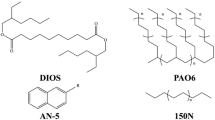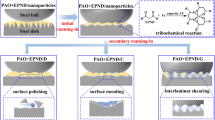Abstract
In order to improve the tribological properties of perfluoropolyethers (PFPE), fluorinated candle soot is adopted as the lubricant additive because of their special onion-like structure. The candle soot particles (CSP) are modified by 1H,1H,2H,2H-perfluorooctanol (CSP-PFHE nanoparticles), and after the fluorination, they exhibit good dispersivity in PFPE. The mixtures composed of CSP-PFHE nanoparticles and PFPE possess better tribological performance than neat PFPE under different test conditions including variable temperature, the irradiation of atomic oxygen and extreme pressure. The reason can be attributed to that the graphene layers are exfoliated from the surfaces of nanoparticles and adhere onto the steel surfaces to form the tribofilm, which can protect the sliding pairs surfaces from friction and severe wear. Meanwhile, the redundant nanoparticles act as the rolling bearing between the sliding surfaces to decrease the wear and some are packed into the corrosion pits generated by PFPE to prevent further erosion in the process of friction. At the end, the lubricating mechanism of CSP-PFHE nanoparticles as additives of PFPE is proposed based on the test results of scanning electron microscope, contact electrical resistance and X-ray photoelectron spectroscopy.
Graphical Abstract














Similar content being viewed by others
References
Tao, Z., Bhushan, B.: Bonding, degradation, and environmental effects on novel perfluoropolyether lubricants. Wear 259, 1352–1361 (2005)
Tyndall, G.W., Waltman, R.J., Pocker, D.J.: Concerning the interactions between Zdol perfluoropolyether lubricant and an amorphous-nitrogenated carbon surface. Langmuir 14, 7527–7536 (1998)
Tonelli, C., Gavezotti, P., Strepparola, E.: Linear perfluoropolyether difunctional oligomers: chemistry, properties and applications. J. Fluor. Chem. 95, 51–70 (1999)
Wang, X., Tan, A.Y.X., Cho, C.M., Ye, Q., He, C., Ji, R., Xie, H.Q., Tsai, J.W.H., Xu, J.: Highly thermally stable cyclotriphosphazene based perfluoropolyether lubricant oil. Tribol. Int. 90, 257–262 (2015)
Nielsen, R.P., Valsecchi, R., Strandgaard, M., Maschietti, M.: Experimental study on fluid phase equilibria of hydroxyl-terminated perfluoropolyether oligomers and supercritical carbon dioxide. J. Supercrit. Fluids 101, 124–130 (2015)
Kasai, P.H., Raman, V.: Z-dol versus Z-tetraol: bonding and durability in magnetic hard disk application. Tribol. Lett. 16, 29–36 (2004)
Chung, P.S., Vemuri, S.H., Park, S., Jhon, M.S.: Molecular rheological analysis on binary blends of perfluoropolyether lubricants. J. Appl. Phys. (2014). doi:10.1063/1.4863265
Kozbial, A., Li, Z., Iasella, S., Taylor, A.T., Morganstein, B., Wang, Y., Sun, J., Zhou, B., Randall, N.X., Liu, H., Li, L.: Lubricating graphene with a nanometer-thick perfluoropolyether. Thin Solid Films 549, 299–305 (2013)
Saperstein, D.D., Lin, L.J.: Improved surface adhesion and coverage of perfluoropolyether lubricants following Far-UV irradiation. Langmuir 6, 1522–1524 (1990)
Huang, H.D., Tu, J.P., Gan, L.P., Li, C.Z.: An investigation on tribological properties of graphite nanosheets as oil additive. Wear 261, 140–144 (2006)
Su, Y., Gong, L., Chen, D.: An investigation on tribological properties and lubrication mechanism of graphite nanoparticles as vegetable based oil additive. J. Nanomater. 2015, 1–7 (2015)
Liang, C., Liao, J., Li, A., Chen, C., Lin, H., Wang, X., Xu, Y.: Relationship between wettabilities and chemical compositions of candle soots. Fuel 128, 422–427 (2014)
Lee, S., Wang, B.: Characteristics of emissions of air pollutants from mosquito coils and candles burning in a large environmental chamber. Atmos. Environ. 40, 2128–2138 (2006)
Pagels, J., Wierzbicka, A., Nilsson, E., Isaxon, C., Dahl, A., Gudmundsson, A., Swietlicki, E., Bohgard, M.: Chemical composition and mass emission factors of candle smoke particles. J. Aerosol Sci. 40, 193–208 (2009)
Petry, T., Cazelle, E., Lloyd, P., Mascarenhas, R., Stijntjes, G.: A standard method for measuring benzene and formaldehyde emissions from candles in emission test chambers for human health risk assessment purposes. Environ. Sci. Proc. Imp. 15, 1369–1382 (2013)
Manoukian, A., Quivet, E., Temime-Roussel, B., Nicolas, M., Maupetit, F., Wortham, H.: Emission characteristics of air pollutants from incense and candle burning in indoor atmospheres. Environ. Sci. Pollut. Res. 20, 4659–4670 (2013)
Menon, S., Hansen, J., Nazarenko, L., Luo, Y.: Climate effects of black carbon aerosols in China and India. Science 297, 2250–2253 (2002)
Liu, H., Ye, T., Mao, C.: Fluorescent carbon nanoparticles derived from candle soot. Angew. Chem. Int. Ed. 46, 6473–6475 (2007)
Boehm, H.P.: Some aspects of the surface chemistry of carbon blacks and other carbons. Carbon 32, 759–769 (1994)
Khanam, A., Tripathi, S.K., Roy, D., Nasim, M.: A facile and novel synthetic method for the preparation of hydroxyl capped fluorescent carbon nanoparticles. Colloids Surf. B 102, 63–69 (2013)
Sahoo, B.N., Kandasubramanian, B.: An experimental design for the investigation of water repellent property of candle soot particles. Mater. Chem. Phys. 148, 134–142 (2014)
Deng, J., Cao, J., Li, J., Tan, H., Zhang, Q., Fu, Q.: Mechanical and surface properties of polyurethane/fluorinated multi-walled carbon nanotubes composites. J. Appl. Polym. Sci. 108, 2023–2028 (2008)
Liu, L., Fang, Z., Gu, A., Guo, Z.: Lubrication effect of the paraffin oil filled with functionalized multiwalled carbon nanotubes for bismaleimide resin. Tribol. Lett. 42, 59–65 (2011)
Kennedy, I.: Models of soot formation and oxidation. Prog. Energy Combust. 23, 95–132 (1997)
Boehm, V.H.-P.: Zur Struktur der Rußteilchen. Z. Anorg. Allg. Chem. 297, 315–322 (1958)
Su, Z., Zhou, W., Zhang, Y.: New insight into the soot nanoparticles in a candle flame. Chem. Commun. 47, 4700–4702 (2011)
Joly-Pottuz, L., Vacher, B., Ohmae, N., Martin, J.M., Epicier, T.: Anti-wear and friction reducing mechanisms of carbon nano-onions as lubricant additives. Tribol. Lett. 30, 69–80 (2008)
Joly-Pottuz, L., Matsumoto, N., Kinoshita, H., Vacher, B., Belin, M., Montagnac, G., Martin, J.M., Ohmae, N.: Diamond-derived carbon onions as lubricant additives. Tribol. Int. 41, 69–78 (2008)
Yu, Q., Huang, G., Cai, M., Zhou, F., Liu, W.: In situ zwitterionic supramolecular gel lubricants for significantly improved tribological properties. Tribol. Int. 95, 55–65 (2016)
Song, Z., Yu, Q., Cai, M., Huang, G., Yao, M., Li, D., Liang, Y., Fan, M., Zhou, F.: Green ionic liquid lubricants prepared from anti-inflammatory drug. Tribol. Lett. (2015). doi:10.1007/s11249-015-0611-5
Daxi, W., Ying, F.: Action mechanism of antioxidation and anticorrosion and molecular design for perfluoropolyether fluid additives. Sci. China Ser. B 44, 428–435 (2001)
Yamaguchi, E.S., Ryason, P.R., Hansen, T.P.: Electrical contact resistance studies on zinc dithiophosphates. Tribol. Lett. 3, 27–33 (1997)
Tsuchitani, S., Morishita, S., Kaneko, R., Hirono, S., Umemura, S.: Evaluation of a lightly scratched amorphous carbon surface by contact resistance of a conductive diamond tip and the carbon surface. Tribol. Lett. 15, 107–113 (2003)
Walker, M.J., Berman, D., Nordquist, C., Krim, J.: Electrical contact resistance and device lifetime measurements of Au-RuO2-based RF MEMS exposed to hydrocarbons in vacuum and nitrogen environments. Tribol. Lett. 44, 305–314 (2011)
Bhowmick, H., Majumdar, S.K., Biswas, S.K.: Influence of physical structure and chemistry of diesel soot suspended in hexadecane on lubrication of steel-on-steel contact. Wear 300, 180–188 (2013)
Ferrari, A.C., Robertson, J.: Resonant Raman spectroscopy of disordered, amorphous, and diamondlike carbon. Phys. Rev. B (2001). doi:10.1103/PhysRevB.64.075414
Acknowledgements
The authors acknowledge the financial support from the National Natural Science Foundation of China (Grant Nos. 51305428, 51675512 and 51227804), Natural Science Foundation of Gansu Province (Grant No. 1606RJZA051) and “973” program (2013CB632301).
Author information
Authors and Affiliations
Corresponding authors
Electronic supplementary material
Below is the link to the electronic supplementary material.
Rights and permissions
About this article
Cite this article
Huang, G., Yu, Q., Ma, Z. et al. Fluorinated Candle Soot as the Lubricant Additive of Perfluoropolyether. Tribol Lett 65, 28 (2017). https://doi.org/10.1007/s11249-017-0812-1
Received:
Accepted:
Published:
DOI: https://doi.org/10.1007/s11249-017-0812-1




